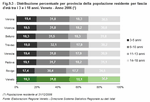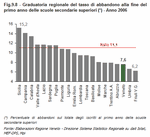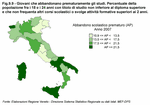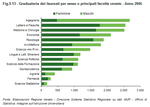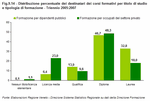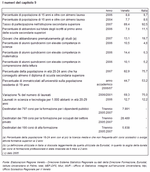|
9 - The school system and educational choices
The development and growth of every country depends on education, it is fundamental not only for the personal life of every child, but also for that of the entire community. The central position of education and training in all economic and social processes has to be acknowledged, as they are basic for assuring the quality of life and better social cohesion.
Only by investing in people throughout their entire lives and promoting high quality education can the success of Europe be assured in the general international context. And if human capital is the strategic resource for European development, it is necessary to constantly improve the quality and effectiveness of the educational and training system as well as to ease everyone's access to all its educational systems. Within this perspective those responsible for the educational policies of the European Union have set strategic objectives for the development of European educational systems to be achieved by 2010: reduce the school dropout rate, increase the number of graduates in mathematics, sciences and technology by at least 15%, also halving the gender gap, guarantee the completion of degrees of higher education for at least 85% of the twenty-two year-old population, supply continuing education to at least 12.5% of the adults between 25-64 years of age, as well as improve the basic skills without which youth or adults risk serious social marginalisation. The Italian educational scene
(Note 1) The stimulus coming from the European Union makes the renewal of the Italian school system, which has been proceeding for some time now, even more indispensable.One response in terms of personal rights can be found in the newly integrated public system of education, in which, according to the current law, public state schools and recognised private schools are part of the public national system of education and possess equal dignity and equal rights. The reform of the Italian system of education laid out by law 53/2003 deals with problems such as basic education, which focuses on the essential knowledge for developing cultural and professional skills that enable dialogue between schools and the wider world; the integration of education and professional training, school and the world of work; and the scholastic success of all students in order to guarantee a new generation of European citizens which respects the principles of cohesion and of social inclusion. The reform includes several crucial issues related to the structure of the system, to its pedagogical-didactic framework, to the relationship between the reform and school autonomy, as well as to federalism. Among these reforms, as far as the structure of the system is concerned, are the overcoming of the division between scholastic obligation and training obligation, the principle of the equal dignity of courses of instruction and professional training, the principle of administrative and organisational subsidiarity in order to bring the real level of governance closer to the needs of users and the definition of general levels of education as well as those relative to local needs, just to name a few. Professional profiles need to be better defined, in order to be comparable on the European level. The same is true for educational standards, competences and their recognition, thus guaranteeing the usefulness of professional qualifications on a national and European level. On the other hand, regarding the pedagogic-didactic framework, the reform indicates the adoption of personalised plans of study that recognise the central role of the student as a priority in the educational process, entrusting the teacher with the role of directing and supporting students, while safeguarding the possibility to maintain a system evaluation. Higher education levels
Even though the process of change concerning the school system is fully underway, some social changes can be observed, that are even more significant than the institutional ones. Over the years there have been notable increases in the percentage of younger schoolchildren and the propensity of families to invest in the future of their children by dedicating more attention to their knowledge and their skills is much stronger.When it comes to higher education, the value for Veneto is still slightly below the national average, but the percentage of university graduates among the population of the age of 15 and older has increased at the same rate as the national average in two years: in 2004 7.7% of the population of Veneto 15 years-old or older and 8.6% of the national population held a degree at least equal to a first university degree, in 2006 the share for Veneto had increased to 8.8% and that of Italy to 9.7%. Generally the increase of the Veneto population with had a high school diploma in 2006 is a bit smaller, i.e. 23.6% of the population as opposed to a national average of 26.9%. (Figure 9.1)
In the 2007-2008 school year there were 4,471 state schools and recognized private schools in the whole region, two thirds of which are nursery schools (39.8%) and primary schools (34.3%). The share of the population (Note 2) to which these institutions are destined - i.e. the population between 3-5 years of age for nursery schools and 6-10 years of age for primary schools - is around 50% of the total school age population (3-18).
Geographically , Verona and Venezia stand out for their greater number of nursery schools (more than 42% of the schools, while Vicenza and Rovigo have the lowest percentages of lower secondary schools. With the exception of nursery schools, where recognized private schools stand out clearly both for the number of schools and for the number of students enrolled, in Veneto state schools predominate in all other types and levels of education. (Figure 9.2) and (Figure 9.3) Nursery schools
Nursery schools represent the first step in education for every child.In the 2006/07 school year, 131,410 children were enrolled in nursery school, with approximately 23 in each classroom. Overall, since the 1994/95 school year the number of children enrolled in nursery school has grown by more than 11%, predominantly in the state schools, where the number of children enrolled has increased by 29%. However, the enrolment percentage, i.e. the percentage of resident children between 3 and 5 years of age enrolled in nursery school, remains much higher in recognised private schools, even if it is decreasing. In 1994/95 nearly three quarters (73.4%) of preschool children were enrolled in a non-state school, later, however, an increase in the degree of participation in public schools has been recorded, an increase which amounted to 31.4% in the 2006/07 school year. (Table 9.1) Primary schools and lower secondary schools
In addition to their strictly educational function, schools represent an important instrument in the social integration of the younger generations of immigrants. One effect of the growing presence of foreigners is the constant increase in the number of foreign students in the schools of Veneto, especially in the primary schools. The degree of overall participation in primary schools and in lower secondary schools, measured by the ratio between the enrolled and the population between 6-10 years of age and 11-13 years of age respectively, exceeds the threshold of 100% both due to its compulsory nature and because there are students enrolled in the schools of Veneto who are non-residents or foreigners who are not enrolled in the municipal registers. In the school year 2006/07 there were 224,100 students enrolled in primary schools, which is 7% more than the school year 2003/04 and 16.6% more than in 1994/95, while there were 131,000 students enrolled in the institutions of lower secondary education. The families of primary school and lower secondary school students continue to choose predominantly public institutions. In the primary schools classes consist of 18-19 students on average, while in recognised private schools there are a little less than 22 students in each class. In lower secondary schools the average of 21-22 students is found in both public and private schools. (Table 9.2) and (Table 9.3) Increased participation in upper secondary education
Participation in upper secondary schools is increasing in Veneto: In 2007 the share of young people between 14 and 18 years of age enrolled in upper secondary school was 89.4%. Compared to seven years before this figure has increased by six percentage points, but it is still below the average Italian value. (Figure 9.4)The choice of secondary school
The choice of secondary school is an important choice that should be considered carefully, not only by the child who is going to attend it, but also by the family that supports him or her. Indeed, a bad decision can delay graduation, and, in the worst case, even at times lead to dropping out of school. However, it is a difficult choice for a thirteen year old child, especially because the options from which to choose are ever more numerous.In the 2007/2008 school year, among the state schools the technical schools attract the highest number of students in Veneto. Even if they are less attractive than some time ago, these schools were still chosen by 37% of students, which is more than three percentage points more than the share recorded on the national level. These schools offer an ever greater choice of specializations, ranging from economic to chemical and electronic fields and many more. The second most popular choice both in Veneto (23%) and in Italy (21%) are professional schools, even if they are less attractive than they used to be. Still these schools are often preferred because they allow the student to learn a profession and to speed up their integration into the workforce, because their training does not necessarily require that they continue their studies by attending university in order to find work, as generally is the case with secondary schools. However, secondary schools are becoming more attractive, especially the scientific ones, which are chosen by 18.5% of the children in Veneto and by 23% in Italy. (Figure 9.5)
At all levels of school, a fundamental role can be attributed to educational success through the reduction of the 'dispersion' phenomenon. This refers to a combination of factors that can extend or interrupt a child's normal school career, leading to poor effectiveness of the system.
In primary and lower secondary schools
Although primary schools figures are always much lower than 1%, it is interesting to note that compared to the relevant data in the preceding year, in the 2004/05 school year the percentages of those not admitted to the next year were lower, especially in the fourth and fifth years, revealing among other things a situation better than that on the national level, while the first year is confirmed as a particularly critical moment. (Table 9.4)The weakness revealed for the first classes are accentuated by the presence of critical elements such as gender or citizenship differences: indeed, a greater risk for male students was found, which is still greater for non Italian citizens. As in primary schools, also in lower secondary schools the beginning of a course of study is the most critical moment for not being admitted to the next year. It is important to note, however, that in only one year a significant reduction in students not admitted was found for those enrolled in the first year. Indeed, the figure for Veneto went down from 4% of non admittance in 2003/04 to 2.6% the next school year. Still more relevant is the improvement seen in the third year that declined by 1.6 percentage points. (Figure 9.6) In upper secondary schools
Considering the data gathered in Veneto for 2004/2005 and 2002/2003 (Note 3) by kind of upper secondary school, the number of students not promoted to the next year for shortcomings in technical subjects showed a significant increase: from 13% of the students evaluated in 2002/03 to 17% two years later. The figure of students not promoted in the area of artistic subjects is significant, it increased from 9% to 13% and in the field of professional education, it went up from 14% to 19%. The number of students promoted to the following year despite a negative mark in one subject also increased: in professional and artistic schools by eight and nine percentage points respectively. On the other hand, the largest percentage of students promoted to the next year without educational shortcomings is to be found in the traditional (classical, scientific, psycho-pedagogical) schools. (Table 9.5) Looking at the results of the evaluations for the ongoing year, the figure for those not promoted to the next year out of first-year students of technical or professional schools is rather significant: in the school year 2004/05 the share amounted to 21% of the students evaluated. The beginning of the second stage of the course of study is always the most difficult. The student has to cope with new classmates, new teachers and a teaching and study methodology which is different from lower secondary school. In addition, in the field of technical education a higher percentage of students not admitted to the next year is generally found in every year of the course. Finally, considering the data by gender, 56% of girls were promoted to the next year - even if with a slightly lower performance compared to the year before - as opposed to 40% of the boys. (Figure 9.7) School drop-outs in upper secondary schools
The beginning of the course of study at upper secondary schools is the most critical moment, which is confirmed also by Istat data on school drop-outs: in Italy in 2006 the percentage of students that interrupted school attendance at the end of the first year and did not enrol for the next school year was 11% of the total enrolled in the first year of upper secondary school. The situation is better in Veneto: it is the third region for the lowest number of drop-outs, with 7.6% of the total of students enrolled in the first year, after Umbria (6.6%) and Friuli Venezia Giulia (6.2%). However, it should be considered that an interruption of schooling, especially in the first year of the course of study, does not always necessarily lead to a definitive abandonment, but often reflects a poor choice of the course of study that is later changed. (Figure 9.8)However, considering the second year of upper secondary schools the number of students who drop out of the course of study is much lower: in 2006 they were only 2.6% in Italy and merely 0.2% in Veneto.
A sound foundation of knowledge is necessary for young people, as less qualified persons find themselves lagging behind in their educational development throughout their lives and run the risk of marginalisation.
Fewer drop-outs in Veneto
Students who leave their studies prematurely are more at risk, which is why the average share of school drop-outs in the EU should be reduced to not more than 10% by 2010.In 2007 in Italy, school drop-outs, i.e. the percentage of young people between 18-24 years of age who have not completed upper secondary school and who do not attend another course of study or attend another training course for at least 2 years, amounted to 19.7%, over three percentage points less than in 2004. The worst conditions are found mostly in the southern regions, in last place is Campania with a drop-out rate of 29%, while the most favourable situation is found in Lazio with a rate in rapid decline and equal to 10.9% in 2007, which is already close to the objective set by the European Union. Veneto also stands out for its rapidly decreasing dropout rate in the past few years: In only three years the number of children that possess only a lower secondary school-leaving certificate and do not attend any course of professional qualification has been reduced by nearly 28%, with a value of 13.1% in 2007, the fourth lowest figure among all Italian regions. This is probably a sign for a proper application of the community directives in the region, and it may therefore be hoped that the EU target will be achieved in the coming years. (Figure 9.9) Basic skills
Employment opportunities depend greatly on a good education, so that in a competitive society like our own, it has become ever more necessary to improve the level of basic skills learned. The PISA (Programme for International Student Assessment) (Note 4) survey allows the verification of the extent to which fifteen-year-olds have acquired specific skills which are essential to participate actively in society. Each individual survey focused on one particular area: in the first study (PISA 2000) it was reading, in the second (PISA 2003) it was mathematics. The most recent study (PISA 2006) focuses on the area of sciences, i.e. scientific literacy, attempting to reveal not only the acquisition of specific knowledge in this area, but also the ability to use these skills in the context of real life.It is the most valuable study to evaluate the teaching effectiveness available today, also because it permits comparison between countries, within the countries, between geographical areas, between kinds of schools, between students with varied social and family backgrounds. PISA 2006 (Note 5) reveals that students in Veneto achieved satisfactory results, whereas Italy as a whole performed below OECD average in all areas, revealing an inferior scientific and cultural competitiveness of Italian youth. The result for Veneto in the sciences is significantly better than the Italian average and than that of the OECD countries, the performance of the youth in Veneto in the area of the scientific explanation of phenomena is good. (Figure 9.10) Boys are more skilled than girls in the field of mathematics and the sciences, the opposite is true when it comes to reading comprehension. There are great differences between types of schools: the university preparatory schools recorded the highest scores in all fields, distancing themselves greatly from the other institutes. The results of the students are also classified according to competence scales divided into different levels of difficulty of the problems solved, proceeding from the easiest to the most difficult. In this respect, the number of young students who reached the highest levels of difficulty remained limited even in Veneto, although its results were well above the OECD average. The percentage of students in Veneto who reached the 5th and 6th levels, the highest on the scale, in sciences and mathematics are 10.5% and 14.4% respectively, compared to the OECD figures of 9% and 13.4%, whereas Italy recorded much lower values for these two disciplines, equal to 4.4% and 6.3%. 10.1% of the fifteen-year-old students in Veneto achieved the highest level of reading comprehension, 8.7% is the average for the OECD countries and 5.2% for Italy.
The school and the university systems are operating in a very dynamic economic and social context. These external conditions greatly affect their internal reality, raising questions about their role and about how they can guarantee courses of study that are in line with the civic and economic needs of the territory. Schools are called on to change along with the context in which they are operating, also because of the propensity of families to invest more in the future of their children by paying more attention to increasing their knowledge and skills. This trend is confirmed not only by the increased attendance of upper secondary schools mentioned above, but also by the continuing increase of students obtaining secondary school-leaving certificates. This certificate is essential, not only for entering the labour market with success, but also because it is required for accessing university and higher level courses which are essential elements for full participation in today's society.
In 2007 in Veneto nearly 83% of young people between 20-24 years of age had at least a upper secondary school diploma, only two percentage points below the target set by the European Council to be reached by 2010. In only three years the region has increased this figure by six percentage points, positioning itself in 2007 in third place in the regional ranking for high levels of upper secondary education. Less positive is the Italian situation that, even if in only three years it has produced an increase of over three percentage points, in 2007 it had reached a rate of 75.7%. (Figure 9.11) The benefits of degrees in higher education
Studying is good for you and is financially worth it. In particular those who complete a degree course benefit, as can be seen from employment data for those with different levels of education: in Italy in 2007 the employment rate for 35-44 year-old graduates was 89.1%, whilst for those with a school-leaving certificate it was 82.7%. The gap is greater still for the 45-54 age group, with 92.8% of graduates in employment, almost 10 percentage points more than those with a school-leaving certificate. Employment levels are even higher for 45-54 year-old graduates in the North-East, 94.3% compared to 89.1% of those with a school-leaving certificate. What is more, even though a graduate's salary is initially not very high when one considers the number of years spent studying and the age at which one begins one's first job, three years after graduation, in 2004 a graduate with a full-time job earned 1,257 euros a month, whilst the average monthly salary for those with a school-leaving certificate was 942 euros. New registrations and number of students in Veneto universities
If we consider the long term figures, it turns out that education and training offered by universities has become much richer and more widely distributed over the whole region, and that participation in the university system has grown. In comparison to 1999/2000, the percentage of nineteen-year-olds who register at the universities of Veneto, i.e. the new entries into the system, has increased from 38.7% to nearly 45% in 2006/2007. In recent years, however, there has been a decrease in registration, which seems to indicate the end of the positive initial effects of the new university organisation that was introduced at the beginning of the decade. With the introduction of the new organisation of university studies and the creation of three-year and specialist degrees, the number of students registered increased enormously until it reached 20,700 in the universities of Veneto in 2003/2004, a percentage of new entries equal to 48.7% of the nineteen-year old population. In the following academic year an inversion of the tendency was found and in 2006/2007, 18,430 new registrations were recorded, a figure four percentage points lower for the nineteen year old population than three years earlier. The new students were 17.6% of the total enrolment in the universities of Veneto with a total of more than 104,400. (Figure 9.12)On the level of the individual university, however, the figures are quite varied: Verona recorded a decrease in registrations of 16.5% compared to 2005/06, while for Padova the decrease was only 1.6%. The latter continues to be the most attended, given the wide range of courses that it offers, accounting for 56% of the new registrations, followed by Verona with approximately 23%, Venezia Ca' Foscari with a bit more than 16% and IUAV of Venice with 4.5%. The region continues to maintain its identification with the humanities: in 2006/2007 the field of literature is still the most popular with newly registered students (more than 12% of the total) and was chosen by 13.6% of the total number of students enrolled. It is followed by economics that was chosen by 11.9% of the young people and hosts more than 11% of the total enrolled. There is also an increasing number of registrations in the field of engineering, coming to nearly 10% compared to 8.6% of two years earlier. Female students accounted for nearly 59% of the new registrations, whereas in the faculties of Educational Science, Foreign Languages and Literature, and Psychology their share exceeds 80%. Engineering courses still are chosen primarily by male students, with more than 84 students out of 100 registered. The graduates
Graduation is essential in today's increasingly dynamic, technological and innovative society and leads to a higher quality of life. In Veneto more and more students are completing their degree courses. In five years there has been a 69% increase in the number of graduates, from just under 12,660 in 2001 to over 21,430 in 2006, over 7% of the number of graduates in Italy. Looking at the performance of the individual universities of the area, a remarkable increase in the number of graduates from the University of Padova emerges, while there is a lower rate of completion from the University of Venezia Ca' Foscari. In first place among the new graduates of the universities of Veneto, and on the increase, are the engineers who were 12.5% of the total number of graduates in the calendar year 2006, followed by students who graduated in Letters and Philosophy and Medicine (with about 12%). In general we observe a larger number of female graduates (59.5%), an obvious consequence of the higher level of participation in the university system, perhaps they are less attracted than males by their first pay cheques. There are many female graduates in the literary and medical fields, on the other hand there is a clear prevalence of males for engineering courses, given the low level of female students in these fields, in which there are only 18 women out of 100 graduates. (Figure 9.13) To live well in today's society, according to the European strategic guidelines, it is necessary to bet on research and innovation and to have a good scientific and technological preparation. For this reason it is becoming ever more important to push for growth in the number of students enrolled and graduates in these disciplines. If the 20-29 year-old age group is considered, on both the national level and in Veneto, the graduates in these subjects are in constant growth. Over the years Veneto has nearly always been above the Italian average, and in 2006 there were little less than 13 graduates in the scientific and technological disciplines in every one thousand inhabitants aged 20-29, with a 16% increase on the previous year, which is a better result than was recorded for the rest of Italy. It should be mentioned that Regione Veneto, in 2007-2008, has invested its own resources to reinforce the effect of the national initiative "Scientific degrees", which is means to support students by educational and informative measures. It is hoped that the initiative will be effective and lead to the desired results.
(Note 6) In its planning for the period of 2000-2006 the European Social Fund, in accordance with community and national priorities, has dedicated important resources to the pursuit of strategic objectives that are directed to improve the quality and efficacy of educational and training systems so as to allow everyone to realise their own potential and update their skills and abilities throughout their life-time.
In the following sections a framework of educational opportunities is outlined for continuous training for employees of the public sector and for employees of firms of the private sector, as well as courses of advanced higher education. Training for public employees
The D2 measure of the ESF programmes was designed specifically to improve the skills of the employees in Public Administration. In the framework of this initiative 797 training courses for public employees have been held in the three-year period of 2005-2006-2007, with a total of about 8,000 participants.Generally the courses are characterised by a very short average duration: about 33 hours distributed usually over 2-3 months. As regards the bodies that have carried out the training courses, they involved employees of 146 local authorities, 18 health authorities, 41 institutions for the welfare of the aged, 8 mountain communities and staff of all provinces of Veneto. The training in particular has involved female employees, who made up 63% of those attending. The distribution of the participants by age group underlines a higher level of participation by older workers: 25.5% of the participants are over 50 years of age, 70.8% between 30 and 50 years of age and only 3.7% under 30 years of age; furthermore, the training has been directed predominantly to personnel with a high school diploma or a university degree, 46.7% and 32.8% of the total respectively, while 6.4% of the personnel involved had only completed lower secondary education and 13.9% had vocational training. (Figure 9.14) Training for private sector employees
Continuous training offered by Regione Veneto within the framework of the ESF refers to activities carried out within measure D1. In the three-year period 2005-2006-2007, there were 28,500 participants in the refresher activities held by firms and training agencies. When it comes to the characteristics of the participants, a certain difficulty in reaching the weaker segments of the labour market was found: only 13.1% of the participants in the courses are over 50 years of age and 18.9% under 30 years of age. (Figure 9.15) The distinction by gender and by academic qualification seems to confirm this tendency: more than 65% of the participants are male and 66.3% have an average-high educational qualification (secondary school-leaving certificate or university degree). The distribution of courses has been heterogeneous in the region: running from a minimum of 19 courses held in the province of Belluno to a maximum of 236 in the province of Padova. The training offered also involved 684 workers who do not have Italian citizenship, most of whom coming from Eastern European Countries. Higher education
In the three-year period considered, there were 190 courses in Veneto targeted to secondary school and university graduates, with highly professional content that involved nearly 6,000 students, most of them between the age of 20 and 25. The distribution by gender underlines a certain numerical advantage for women, i.e. a share of 60% of the students enrolled. The share reaches even 75% for the courses in restoration.The number of hours in class of the courses offered ranged from a minimum of 600 up to 1,200 hours. In particular, there were 46 courses offering individual training of substantial complexity and high specialization, which required students to attend for a long period both in terms of hours (i.e. 1,200) and duration (10-12 months). In terms of the types of courses activated, the range was quite varied. Predominantly, instruction was in the sectors of information technology, cultural goods (20 courses in restoration were held), environment and technology. The high quality and variety of the training courses attracted also a considerable number of students from outside the region: 1,344 people, or 22.6% of the total. (Table 9.6)
|
|
Data elaborated by the Statistics office of the Veneto region are collective property; reproduction of this material is authorised for non-commercial purposes only, provided the source "Regione Veneto - Regional Statistics System Management" is acknowledged.


 Index
Index  Home
Home 

